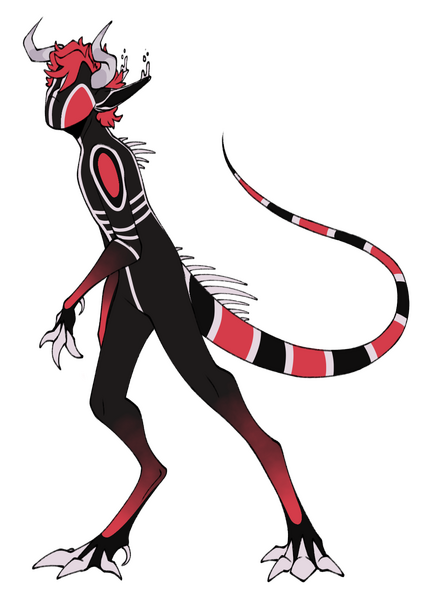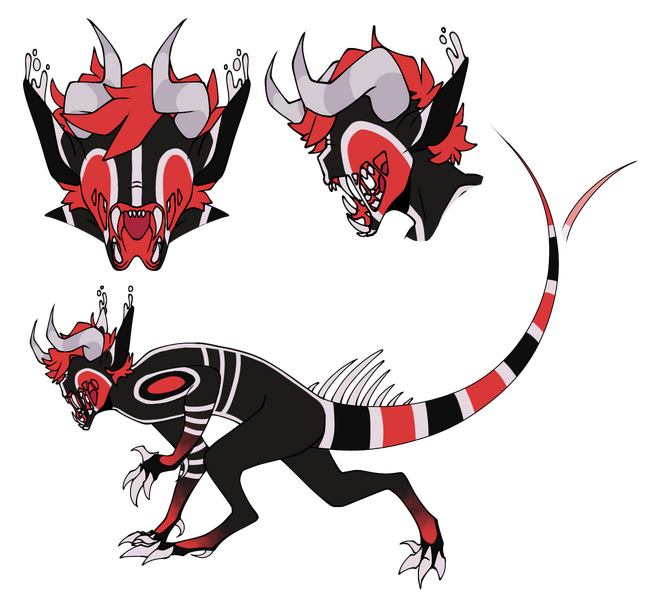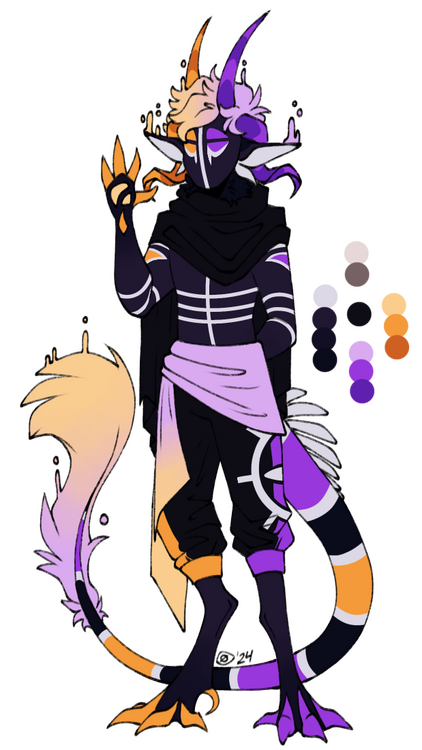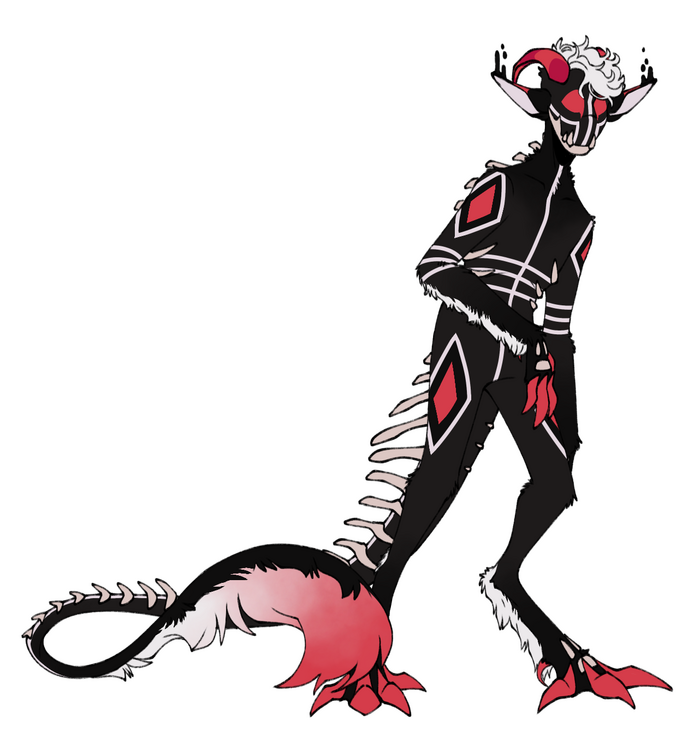rebel red species
so by now you've either read everything and are asking "blurry what the fuck is a voidstalker/flametail/etc." or you came here first. either way, this is where i explain them. both are my own original species.BOTH THESE SPECIES ARE OPEN SPECIES FEEL FREE TO MAKE A SPIRITUX OR VOIDSTALKER OC IF YOU WANTone rule is no grayscales, so no pure black or pure gray without any color tint to it. white is fine and any grayscale with a tint, like a reddish gray or a bluish gray. other than that, keep within halloween themes for spirituxes and no extra limbs or stuff like that. but have fun with them.fun fact: the name "voidstalker" isn't even the species' actual name. that has been forgotten and lost, and the name voidstalker is a derogatory term the flametails use to describe them based on a myth that they can travel through shadows, or "stalk the voids."VØIDSTALKERS
Versipellis obscurum
External Physiology:Voidstalkers are a species of bipedal humanoid shapeshifters. They are mostly black in color, with additional darker and white markings across their bodies. Each individual has another color, for example Blurry and Spooky's red, which determines which color they are able to see in their full capacity. In their vision, every other color is heavily muted. Red is the most common. Those with two colors are uncommon, and three colors are especially rare. Arrangements of spikes, spines, or other assorted things on their bodies are possible too, and not too uncommon.Voidstalkers do not form with all of their markings, rather developing over the course of a few months after they are formed. False eyes and striped tails are very common markings, as well as the white striping on their faces, torsos, and arms which denote ancestry or geographical origin. Each individual has a unique marking, which serves as an identifier for the individual (Ex: Blurry's black neck and hands, Spooky's red eye markings.) These markings are the only ones that cannot be shifted away, and follow them across all forms they take. Like every other being from the Spiritux World, they have five-striped horns which match their eye color. These horns emerge around 3-4 years of age, and are used culturally to signify adulthood.Besides that, Voidstalkers have four fingers and toes, with two joints each as opposed to a human's five with three joints. They are ambush predators, and are built for climbing. Their digitigrade legs and tail are exceptionally strong, the latter being prehensile and also used for balance purposes. They are capable of holding their own weight up with their tails alone. Other natural weapons they possess include their claws on each finger and toe, which can be locked to keep prey down, as well as spurs on their wrists and ankles. These spurs are derived fifth fingers/toes, and allow them to use their poisonous and corrosive "blood" as a sort of venom, which at its weakest can make prey sick, and kill nearly instantly at its worst. They possess elongated canine teeth, hidden along with the rest of their teeth behind their seemingly featureless faces and glowing eyes.Voidstalkers are, on average, slightly shorter than the average human, with those on the shorter end being around 5 feet tall, and higher extremes at 6 feet (1.5-1.8 meters).
Internal Physiology:Starting with the most glaring differences, Voidstalkers (and all other entities from their world) do not have the traditional organ setup seen in Earth animals. Much of their bodies are composed of a singular substance, which as mentioned before is corrosive and poisonous. It fufills many bodily functions, such as respiration, circulation, digestion, reproduction, and more. In the place of a muscular, skeletal, and nervous system, a system of "nerves" run throughout their bodies. These nerves convene at the Core, located in their chests, which serves as a joint heart and brain. It is protected by a thick shell, like a human's ribcage. If damage to the Core is substantial enough, the Voidstalker will die.They lack a sense of smell or taste, but make up for it with exceptional eyesight and hearing, especially at night due to them being nocturnal. This lack of smell can work in their favor, as they can emit an odor like that of rotting flesh as a defense mechanism. Voidstalkers are sensitive to bright/flashing lights and loud/sudden noises, making them frightened and panicked. They also lack the ability to hold their breaths, a side effect of both not having evolved near much water and because of their lack of lungs, breathing through their skin instead. If a Voidstalker gets fully submerged in water or any liquid, they will begin suffocating almost immediately.Voidstalkers have two methods of gaining energy. The first is through traditional predation and consumption of energy from other beings. The second is a fair bit more complex, allowing them to directly draw energy from their surroundings, similar to photosynthesis in plants. This method is not meant to be permanent, and more of a last resort. If too much energy is stored within their bodies and it remains unused, it will overwhelm the Core and it will forcibly expel all energy from the body via vomit. The Voidstalker then falls unconscious. It can take up to a full 24 hours for an adult Voidstalker to wake up again, and even then they need a couple more days to regain enough strength to get up and move around again. Some are forced to use this method for a variety of reasons. It can be sustainable if managed properly, but usually causes just as many problems as it solves.Voidstalkers are excellent at mimicry. It is arguably what they are most well-known for in their home world, being the only living species to retain a shapeshifting ability from their ancestors. If given enough time, Voidstalkers tend to pick up traits from groups or species they spend time with or live with. Their shapeshifting relies on knowledge. If an individual has seen something and understands how it functions, they will be able to shift it and replicate its function to the best of their ability. There is no real limit to what they can shift into, it just needs to be similar in size to their own bodies.The species' body temperature is on average colder than a mammal's, usually staying in the mid to high 80's F (29.4-31.7C).
Social/Behavior:As insinuated prior, Voidstalkers are highly adaptive creatures. This is the primary reason why, post-Scorching, they have survived as well as they have been. They can also be highly aggressive and territorial with one another. They are known to form close bonds with those they care about, and can become highly protective over these other individuals. They show trust or affection by wrapping their tails around others.Much of their communication is unique to small groups, but more species-wide signals are done through simple noises such as clicks, growls, and hisses, or through body language. Any form of written or spoken language they may have had in the past is now lost to time.Before they became fragmented, they held a belief in a being known as the Allsight, who they believed would help them during a time of need. As this being’s name suggests, they can see all colors, which would rank them the highest in their society.
SPIRITUXESnow for the spirituxes. they evolved from a group of voidstalkers who ventured beyond their world, and found a niche in guiding people. they gradually lost their shapeshifting ability, finding that a cat-like form was most appealing to those they wanted to help. they also over time took after the human holiday of halloween, as cats were a large symbol during that time of year, when it was easiest for the two worlds to connect.their internal physiology is nearly identical to that of a voidstalker, the only difference being in them having a more defined skeleton.externally is where the differences between the two show the most.-spirituxes are quadrupeds, and are about double the size of a house cat. they have longer ears than cats , and lack retractable claws. their thumbs face inwards, and have rabbit-like noses.-they can be classified into three distinct species:
SMOKETAILS
(Laruafelis fumigans)The largest and most robustly-built of the three species, but also the most brightly-colored. They have small and short horns, with three stripes instead of the usual five of most creatures in their world. They have a smoke-like substance trailing off their limbs, ears, and comprising the whole of their tails. Their fur is bioluminescent, becoming almost neon in their home territory at night. Their eyes have black sclera and two colored rings, the iris being darker than the pupil.Due to the region they inhabit being full of waterways, water is very important to them. To them, water has life and stores life in it. Wherever water touches, life is present or follows soon behind it. When Smoketails die, they put the bodies in the water so that their life can return to the water it came from, and the cycle can start over again. They are extremely defensive over the water in their lands.Smoketails live in medium-sized groups, usually made up of a few families each. These groups tend to have one leader that serves as a representative for larger meetings. These meetings occur on an island with a large willow-like tree in the center of the territory. The meetings serve as a type of government for the whole.They tend to be the most friendly of the three species and the most welcoming, but are also the strongest and will not hesitate to defend themselves if necessary. Like the Bonetails though, they do not start conflicts very often, and when conflict arises, they are good mediators due to their gentle nature and physical strength.
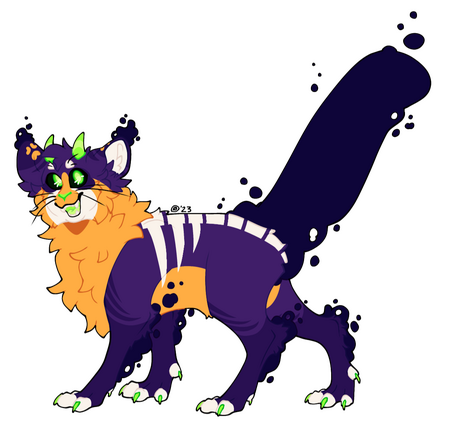
FLAMETAILS
(Laruafelis ignis)A medium sized species, the Flametails are duller in color compared to other Spirituxes, but make up for it with almost neon flames coming off their ears and limbs, as well as making up their tails. When they get angry or upset, flames start trailing out from either side of their mouths. They are the fastest of the three species, and have quick tempers. They are very territorial and aggressive towards others.Flametails have long and curled horns, which they will sometimes use for offensive purposes, like headbutting each other. They are extremely competitive amongst themselves and among other species, viewing themselves as superior to everybody else. Flametails are the only current group to build their homes rather than living in natural structures or carving out homes for themselves.They are also unique for not having a very strong belief in any natural thing. Some Flametails will tell stories that have been passed down through generations of times when fire held importance, times when fire was believed to carry the spirits of ancestors and keeping fire in your homes would allow the ancestors’ spirits to be able to interact with the living family and stay with them even in death.Now, however, those beliefs are not nearly as common as they used to be. There is a higher focus on maintaining their superiority, and a higher focus on conformity within their society. They have a very structured government compared to other species’. They do choose their leaders, though, which is also different from the other species’.
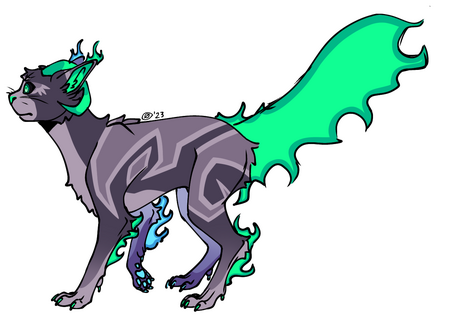
BONETAILS
(Laruafelis osseum)The smallest of the three species, with a skull for a face instead of fur. They tend to have longer and higher-standing horns than the others, and a mane of fur around their necks. They also have an extremely slender build, appearing emaciated or malnourished. Their tails are skeletal, like their heads, and are equipped with a sharp spine for defensive and offensive purposes. Coloration wise, they tend to have pale bodies with more saturated and darker colors in their manes and extremities.They also have two-ringed eyes, with a white pupil and colored irises, and the standard black sclera.Familial connections are very important to Bonetails, living together in a singular large family cave. When Bonetails die, their skulls are kept with their families, as it is believed among them that the skulls of the deceased carry their souls with them, and that keeping them with their family allows the spirit of the deceased to watch over their relatives. They will also keep the skulls of the prey they kill out of respect for their souls.They live in large groups, with a council in charge of decision-making for the whole. The council has one member of each family in it, so that decisions reflect the wants and needs of the whole rather than the desires of a few high-ranking families.Bonetails are somewhat aggressive and very competitive and confident in their abilities, using their horns and tails to spar with one another. However, they are not violent towards other groups, and do not tend to start conflict.
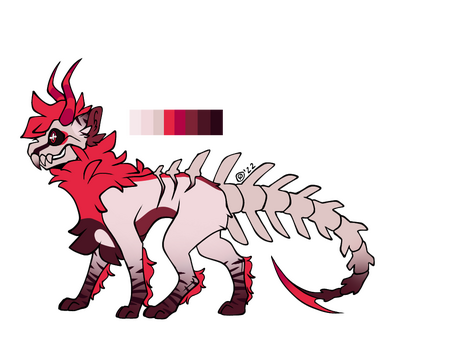
I still need to update some of my spiritux ocs' refs, spooky (the bonetail)'s ref is inaccurate.
HYBRIDS
Due to these species' close relation to one another genetically, hybridization is possible. These beings do not live the best lives, though, in comparison to their pureblood counterparts. The multiple sets of genetics from different species do not mix nicely with one another, leading to developmental issues like stunted growth and usual milestones coming much later, if at all. Many also are forced to rely on secondary methods of obtaining energy, having to draw in energy from their surroundings as their bodies cannot process food normally and it can cause much more harm than good for the individual. They are more susceptible to energy overloads, and their "blood" tends to be less potent. They can have slightly better senses than either component species, though, and each individual has their own unique set of traits.
